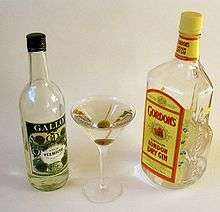Three-martini lunch

The three-martini lunch is a term used in the United States to describe a leisurely, indulgent lunch enjoyed by businesspeople or lawyers. It refers to a common belief that many people in such professions have enough leisure time and wherewithal to consume more than one martini during the work day. Steaks, oysters and lobster are among dishes cited as a staple of these lunches.
As business matters may be discussed at them, three-martini lunches are considered a business expense (which includes travel, meals, etc.) and thus can qualify for a tax deduction.[1]
Decline and comeback
The three-martini lunch is no longer common practice for several reasons, including the implementation of "fitness for duty" programs by numerous companies, the decreased tolerance of alcohol use,[2] a general decrease in available leisure time for business executives,[3] an increase in the size of the martini, and a decrease in the size of the tax deduction.[1]
President John F. Kennedy called for a crackdown on such tax breaks in 1961, but nothing was done at the time.[4] Jimmy Carter condemned the practice during the 1976 presidential campaign.[1] Carter portrayed it as part of the unfairness in the nation's tax laws, claiming that the working class was subsidizing the "$50 martini lunch".[5] This was because a "rich businessman" could write off this type of lunch as a business expense. After the election his opponent, incumbent President Gerald Ford, in a 1978 speech to the National Restaurant Association, responded with: "The three-martini lunch is the epitome of American efficiency. Where else can you get an earful, a bellyful and a snootful at the same time?"[1][6][7]
The entertainment deduction, which includes meals, was reduced to 80 percent in 1987 and to 50 percent in 1994.
Comedian George Carlin once commented that the crackdown on the three-martini lunch should not affect the working man's "two-joint coffee break".
See also
References
- 1 2 3 4 Kuntzman, Gersh, "Martinis for Victory!", Newsweek, October 22, 2006 (URL last accessed March 13, 2008). Archived March 5, 2009, at the Wayback Machine.
- ↑ Sorich, Sonya (October 26, 2006). "Business drinkers walk fine line". Columbus Ledger-Enquirer. Archived from the original on February 6, 2007. Internet Archive; URL last accessed June 4, 2010).
- ↑ Drummond, Mike, "What Ever Happened to the 3 Martini Lunch?", The Charlotte Observer, March 14, 2005 (URL last accessed October 30, 2006)
- ↑ Jonathan Gruber (December 21, 2004). Public Finance and Public Policy. Macmillan. p. 500.
- ↑ Stratton, Jeremy (January 2, 2006). "The decline of the three-martini lunch". Downtown Journal. Minneapolis-St. Paul.
- ↑ Gray, W. Blake (December 2, 2004). "Trends change but the martini is always cool". San Francisco Chronicle.
- ↑ Andrew F. Smith (May 1, 2007). The Oxford Companion to American Food and Drink. Oxford University Press. p. 367.
